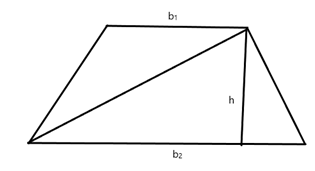
a
To prove: Area of trapezoid using a diagonal and two
a
Explanation of Solution
Given information : Trapezoid divided into two triangles by diagonal.
Formula used : Area of triangle =
Prove: Let
Area of trapezoid = Area of Triangle 1 + Area of Triangle 2
Now, area of triangle 1 =
Similarly, area of triangle 2 =

b
To prove: Area of trapezoid using altitudes, rectangles and triangles.
b
Explanation of Solution
Given information : Trapezoid divided into two triangles and one rectangle
Formula used : Area of triangle =
Prove: Let
Area of trapezoid = Area of Triangle 1 + Area of rectangle + Area of Triangle 2
Now, area of triangle 1 =
Similarly, area of triangle 2 =
Here, breadth of rectangle is same as height of triangle,

Chapter 11 Solutions
Geometry For Enjoyment And Challenge
Additional Math Textbook Solutions
Precalculus: Concepts Through Functions, A Unit Circle Approach to Trigonometry (4th Edition)
College Algebra with Modeling & Visualization (5th Edition)
Essentials of Statistics, Books a la Carte Edition (5th Edition)
Calculus for Business, Economics, Life Sciences, and Social Sciences (13th Edition)
Fundamentals of Differential Equations and Boundary Value Problems
Elementary and Intermediate Algebra: Concepts and Applications (7th Edition)
 Elementary Geometry For College Students, 7eGeometryISBN:9781337614085Author:Alexander, Daniel C.; Koeberlein, Geralyn M.Publisher:Cengage,
Elementary Geometry For College Students, 7eGeometryISBN:9781337614085Author:Alexander, Daniel C.; Koeberlein, Geralyn M.Publisher:Cengage, Elementary Geometry for College StudentsGeometryISBN:9781285195698Author:Daniel C. Alexander, Geralyn M. KoeberleinPublisher:Cengage Learning
Elementary Geometry for College StudentsGeometryISBN:9781285195698Author:Daniel C. Alexander, Geralyn M. KoeberleinPublisher:Cengage Learning

